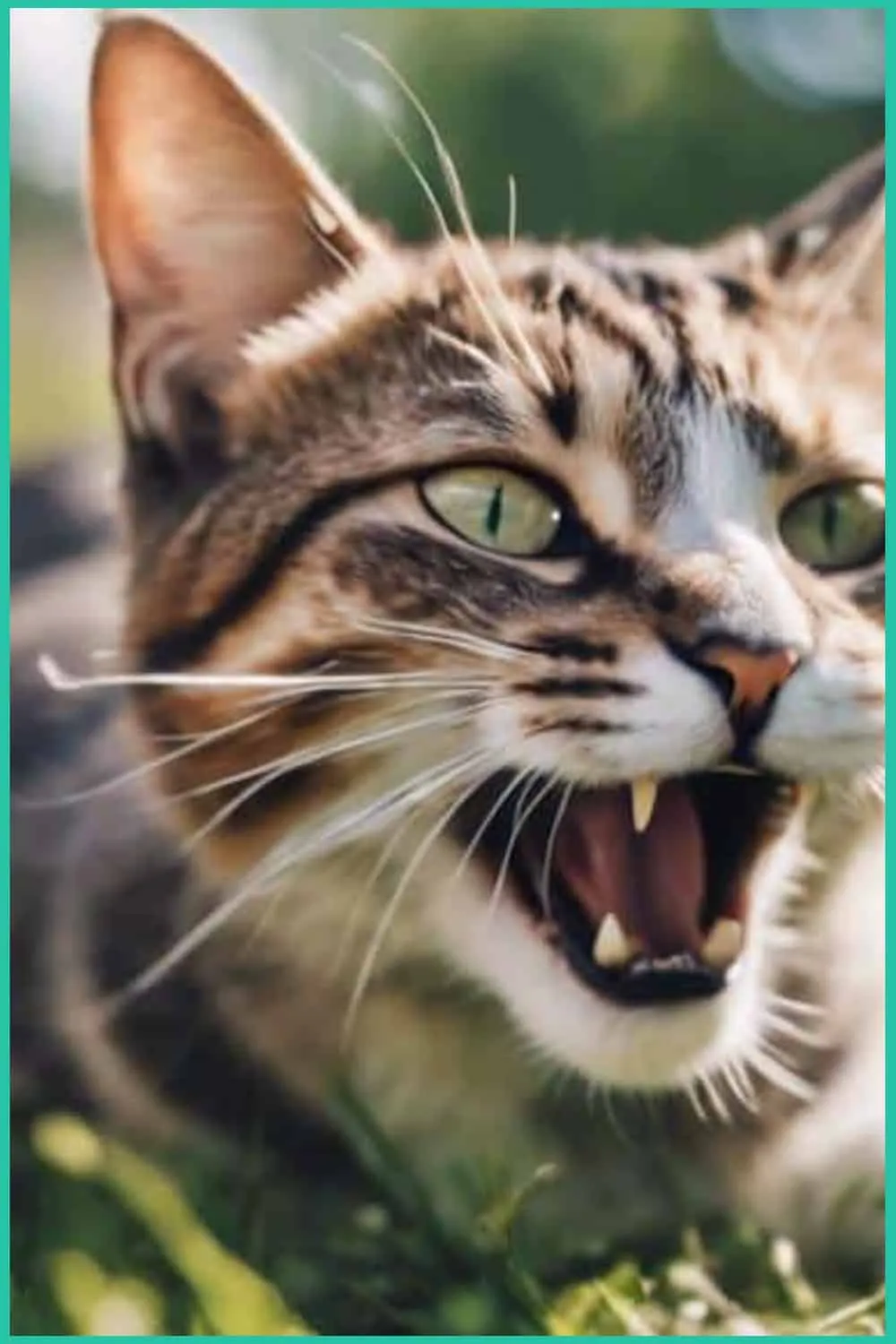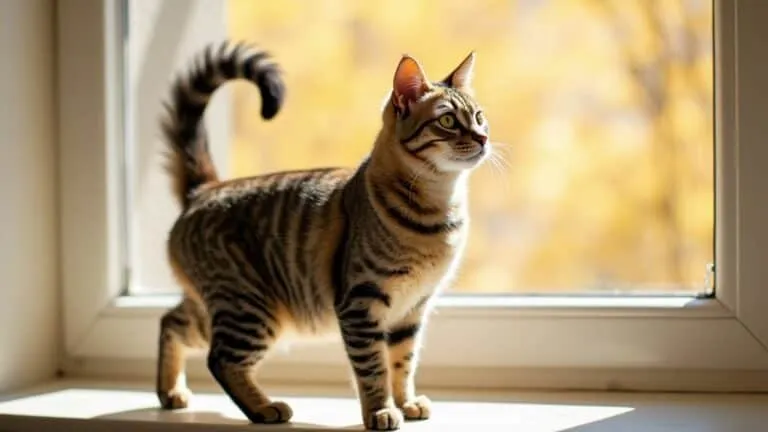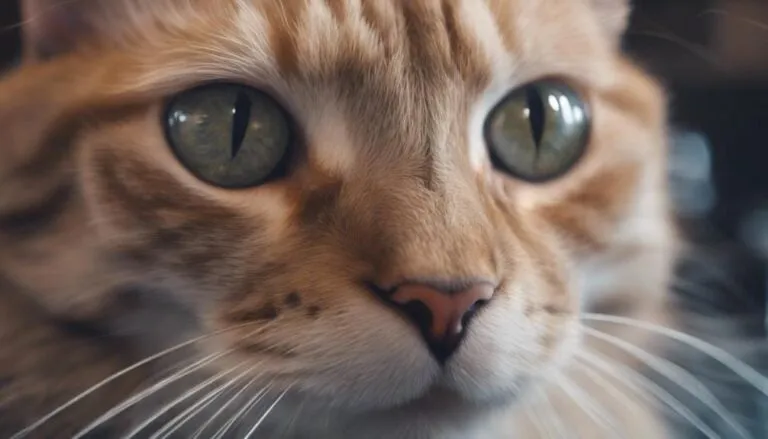The Best Fluffy Pancakes recipe you will fall in love with. Full of tips and tricks to help you make the best pancakes.

If you've ever wondered why your cat has a little nibble at your nose, there may be more to it than meets the eye. The gentle biting behavior could reveal fascinating insights into your feline friend's emotions and connection with you. Understanding the reasons behind this unique form of communication can shed light on the intricate bond that you share with your cat. So, the next time your kitty playfully nips at your nose, remember, there might be a deeper meaning behind this seemingly simple gesture.
Key Takeaways
- Nose biting can be a playful behavior.
- Cats may use nose bites to seek attention.
- Biting could be a sign of affection.
- It might indicate a desire for interaction.
- Understanding cat body language helps interpret nose biting.
Understanding Feline Communication Signals
If your cat bites your nose, understanding feline communication signals can provide valuable insight into their behavior. Cats communicate through body language and vocal cues, which can help you decipher their intentions and feelings.
When it comes to body language, pay attention to your cat's ears, tail, and overall posture. Ears flattened back against the head may indicate fear or aggression, while a tail held high signifies confidence or happiness. If your cat arches their back and hisses, they're likely feeling threatened or defensive. Understanding these cues can help you determine when your cat is feeling comfortable or stressed.
In addition to body language, vocal cues also play an important role in feline communication. Cats meow, purr, hiss, growl, and chirp to convey various emotions and needs. A short, high-pitched meow may signal excitement or a greeting, while a deep, guttural growl typically indicates anger or warning. By paying attention to these vocalizations, you can better understand what your cat is trying to express.
Instinctual Behavior Patterns in Cats
When observing your cat's behavior, it becomes evident that instinctual behavior patterns play a significant role in shaping their actions and responses. Cats possess inherent predatory instincts, which drive behaviors such as stalking, chasing, and pouncing on prey-like toys or even your toes under the blanket. These behaviors stem from their ancestors' need to hunt for survival. Additionally, territorial behavior is another instinct deeply ingrained in cats. They mark their territory by scratching, rubbing their scent glands, and even sometimes biting in defense of their space.
In addition to these instincts, cats also exhibit behaviors related to social hierarchies and hunting techniques. In a multi-cat household, you may notice dominant cats asserting their authority through body language, vocalizations, and even physical confrontations to establish their place in the hierarchy. When it comes to hunting, cats display cunning tactics, such as stealthy approaches and swift movements to catch their prey.
Understanding these instinctual behavior patterns can help you provide enriching environments that cater to your cat's natural inclinations, promoting their overall well-being and happiness.
Signs of Affection or Playfulness
As you observe your cat's behavior, you may notice subtle cues that indicate signs of affection or playfulness. Nose boops are a common way that cats show affection towards their human companions. These gentle touches with their nose can be a way of seeking attention, showing comfort, or simply expressing love. When your cat engages in nose booping, it's a sign that they feel comfortable and connected to you.
Playful nibbles are another behavior that can indicate bonding and playfulness. Cats may lightly nibble on your hand or fingers during playtime as a way to interact and have fun. This behavior is often a display of trust and comfort, showing that your cat sees you as a companion and enjoys spending time with you.
Understanding these subtle signs of affection and playfulness can help strengthen the bond between you and your feline friend. By reciprocating these gestures in a positive way, you can further nurture a loving and playful relationship with your cat.
Setting Boundaries With Your Cat
Establish clear boundaries with your cat to promote a harmonious and respectful relationship. Consistency is key when training boundaries for your feline friend. Cats thrive on routine and structure, so setting clear rules and sticking to them will help establish a sense of security and understanding for your pet.
When setting boundaries, be firm but gentle. Use positive reinforcement techniques such as treats or praise to encourage good behavior and redirect unwanted actions. For example, if your cat tends to scratch furniture, provide a scratching post as an alternative and reward them when they use it.
It's important to communicate your boundaries effectively. Use a firm tone of voice and consistent body language to convey your expectations. Cats are intelligent animals and will quickly learn what's acceptable behavior if boundaries are consistently enforced.
Stress and Anxiety Triggers
To help your cat cope with stress and anxiety triggers, it's important to recognize the signs of distress and create a calming environment for your feline companion. Coping strategies and relaxation techniques can be beneficial in reducing your cat's stress levels. Providing safe spaces, such as cozy hiding spots or high perches, can offer a sense of security.
Additionally, engaging your cat in interactive play sessions and maintaining a consistent routine can help alleviate anxiety.
Behavioral therapy and stress management can also be effective in addressing your cat's emotional well-being. Consider consulting with a veterinarian or animal behaviorist for professional guidance on how to manage your cat's stress and anxiety.
Implementing environmental enrichments like puzzle feeders, scratching posts, and interactive toys can stimulate your cat's mind and provide mental stimulation, aiding in stress reduction.
Health Issues and Veterinary Concerns
If your cat is consistently biting your nose, it's imperative to explore potential health issues that might be causing this behavior. Regular check-ups with your veterinarian can help identify any underlying medical problems that could be contributing to your cat's actions.
Addressing any health concerns is vital in ensuring the well-being of your feline friend and promoting a harmonious relationship between you and your cat.
Common Health Problems
Experiencing common health problems in your cat can be concerning, but understanding potential issues and seeking veterinary care promptly is essential for their well-being.
- Dental Health: Regular dental check-ups are important to prevent dental diseases in your cat.
- Weight Management: Monitoring your cat's weight and providing a balanced diet is essential for their overall health.
- Preventative Care: Routine vaccinations and parasite prevention help keep your cat healthy and protected.
- Dietary Needs: Meeting your cat's specific dietary requirements according to their age and health condition is crucial for their well-being.
Being proactive about your cat's health by addressing these common issues can help ensure they lead a happy and healthy life.
Importance of Check-Ups
Regular veterinary check-ups play an essential role in maintaining your cat's health and addressing any potential issues promptly. These routine exams are vital for preventive care and early detection of any health concerns. By scheduling regular check-ups, you can guarantee that your feline companion stays healthy and happy.
Wellness plans provided during these visits help in monitoring your cat's overall well-being and preventing any potential health issues from escalating. Your veterinarian can also offer advice on nutrition, behavior, and any specific care your cat may need.
Investing in these check-ups is investing in your cat's long-term health and quality of life. Remember, preventive care is key to ensuring your cat's health and happiness.
Behavioral Triggers to Address
Addressing behavioral triggers linked to health issues and veterinary concerns in your cat is essential for ensuring their overall well-being and happiness. When dealing with these issues, consider the following:
- Body language interpretation: Understanding your cat's body language can provide valuable insights into their emotions and potential triggers for biting behavior.
- Training methods: Implement training techniques that focus on redirecting your cat's biting behavior towards more appropriate outlets.
- Behavioral modification: Work with a professional to develop a customized behavioral modification plan that addresses your cat's specific triggers and encourages positive behavior.
- Positive reinforcement: Reward good behavior with treats, toys, or affection to reinforce positive habits and discourage biting tendencies.
Training Techniques for Redirecting Behavior
When addressing your cat's behavior, consider using positive reinforcement methods to encourage desired actions.
Interactive play alternatives can help redirect your cat's energy and prevent unwanted biting behavior.
Setting consistent boundaries and rules will also aid in shaping your cat's behavior positively.
Positive Reinforcement Methods
To effectively redirect your cat's behavior, use positive reinforcement methods consistently and patiently. Positive reinforcement can help encourage good behavior and discourage unwanted actions in your feline friend.
Here are some tips to assist you in using positive reinforcement techniques effectively:
- Clicker training: Use a clicker to mark desired behaviors and follow up with treat rewards.
- Treat rewards: Reward your cat with treats when they exhibit positive behaviors.
- Behavior modification: Focus on modifying unwanted behaviors through positive reinforcement.
- Training consistency: Stay consistent with your training methods to help your cat understand what's expected.
Interactive Play Alternatives
Engage your cat in interactive play sessions using toys to redirect their behavior positively and provide mental and physical stimulation. When your cat is exhibiting behavior like nose booping or playful pouncing, it might be a sign that they need an outlet for their energy.
Try using a feather wand for them to chase or a laser pointer for an exciting chase around the room. These activities not only keep your cat entertained but also help them release excess energy in a healthy way.
Consistent Boundaries and Rules
Establishing consistent boundaries and rules is crucial in effectively redirecting your cat's behavior and fostering a harmonious relationship with them. To guarantee successful feline discipline and a happy coexistence, consider the following:
- Training consistency: Regular training sessions help reinforce positive behaviors and discourage negative ones.
- Behavior boundaries: Clearly define what behaviors are acceptable and unacceptable to avoid confusion.
- Feline discipline: Use gentle but firm methods to correct unwanted behaviors and encourage good ones.
- House rules: Set clear rules within your home environment to provide structure and guidance for your cat.
Interactive Play and Enrichment Activities
Interactive play and enrichment activities are vital for keeping your cat mentally stimulated and physically active. Enrichment toys and interactive games play an important role in providing your feline friend with mental and physical exercise. Enrichment toys, such as puzzle feeders or treat-dispensing balls, can help stimulate your cat's problem-solving skills and prevent boredom. Interactive games like wand toys or laser pointers are excellent for engaging your cat in physical activity and promoting bonding between you and your pet.
When engaging in interactive play with your cat, it's important to make sure the activities are safe and appropriate for your cat's age and abilities. Rotate the enrichment toys regularly to maintain your cat's interest and prevent them from getting bored. Additionally, set aside dedicated time each day for interactive play sessions to keep your cat active and mentally engaged. By incorporating these enrichment activities into your cat's routine, you can help prevent behavioral issues and ensure your furry companion leads a happy and healthy life.
Consistency in Reinforcing Positive Interactions
To foster a positive relationship with your cat and reduce nose-biting behavior, it's essential to consistently reward good behavior. Utilize treats strategically to reinforce positive interactions and establish clear boundaries to communicate effectively with your feline companion.
Reward Good Behavior
Consistently rewarding good behavior in your cat is essential for reinforcing positive interactions and strengthening your bond. Positive reinforcement techniques like clicker training and treats can be highly effective in encouraging desirable behaviors.
Here are some tips to help you reward your cat's good behavior effectively:
- Use play therapy as a rewarding activity after your cat displays good behavior.
- Offer treats as a way to positively reinforce desired actions.
- Provide verbal praise and gentle petting to show your cat affection and approval.
- Incorporate interactive toys or activities as additional rewards for good behavior.
Use Treats Strategically
Rewarding your cat strategically with treats is a key aspect of reinforcing positive interactions consistently. Treat training involves using positive reinforcement to encourage desired behaviors in your feline friend. When your cat behaves well, such as not biting your nose, promptly offer a treat to reinforce that behavior positively.
Choose treats that your cat loves and are small enough for quick consumption during training sessions. Be consistent in rewarding good behavior to help your cat understand what's expected of them. Positive reinforcement through treats creates a positive association, making your cat more likely to repeat the desired actions.
Establish Clear Boundaries
When setting boundaries with your cat, remember that consistency in reinforcing positive interactions is key to establishing a harmonious relationship.
- Establishing Trust: Cats thrive on trust; show your cat that you're a reliable and consistent presence in their life.
- Setting Limits: Clearly define what behaviors are acceptable and unacceptable, and consistently reinforce these boundaries.
- Positive Reinforcement: Reward good behavior with treats, pets, or playtime to reinforce positive interactions.
- Redirecting Negative Behavior: Instead of punishing your cat, redirect their attention to a more appropriate activity when they overstep boundaries.
Seeking Professional Behavior Advice
Seeking guidance from a professional behaviorist can provide valuable insights into understanding and addressing your cat's nose-biting behavior. A behaviorist can assist with behavior modification techniques tailored to your cat's specific needs. Professional guidance is essential in identifying the root cause of the biting behavior, whether it's due to fear, aggression, or other underlying issues. These experts can offer training techniques and expert advice on how to effectively communicate with your cat and set boundaries to prevent nose-biting incidents.
Professional behaviorists have the expertise to create personalized behavior modification plans that focus on positive reinforcement and understanding your cat's body language. By seeking their help, you can learn how to redirect your cat's behavior in a positive way and strengthen your bond with your furry friend. Remember, seeking professional advice isn't a sign of weakness but a proactive step towards creating a harmonious relationship with your cat.
Frequently Asked Questions
Can My Cat's Biting Behavior Be a Sign of Boredom?
When your cat bites, it could signal boredom. Engage them with enrichment toys and interactive play. Rotate toys to keep things exciting. Providing mental and physical stimulation can reduce biting behaviors and strengthen your bond.
How Can I Prevent My Cat From Biting During Grooming?
To prevent your cat from biting during grooming, incorporate behavior modification techniques. Use positive reinforcement, such as treats. Distract and redirect their attention with toys. Consistent training can help improve their behavior over time.
Is There a Way to Distinguish Between Playful and Aggressive Biting?
To distinguish between playful and aggressive biting in cats, observe their body language cues. Tail position, ear angle, and vocalizations can signal intent. Use positive reinforcement training techniques to redirect behavior. Consistency and patience are key.
What Should I Do if My Cat Only Bites Me and Not Others?
If your cat only bites you, consider behavioral training. Use positive reinforcement and training techniques to discourage this behavior. For example, reward gentle interactions with treats. Consistency and patience will help modify your cat's behavior.
Are There Specific Toys or Activities That Can Help Reduce Biting Behavior?
To reduce biting behavior, try interactive toys and training techniques. Engage your cat with mental stimulation through enrichment activities. Providing these outlets can help redirect your cat's energy and discourage biting.
Conclusion
As you navigate the playful nose bites from your cat, remember that each nibble is like a gentle melody in the symphony of your bond.
By understanding their communication signals and setting boundaries with love, you can foster a harmonious relationship filled with affection and trust.
Stay consistent in reinforcing positive interactions and seek professional guidance if needed to guarantee a purrfect connection with your feline friend.
Embrace the nose boops as a sweet note in your shared song of companionship.










